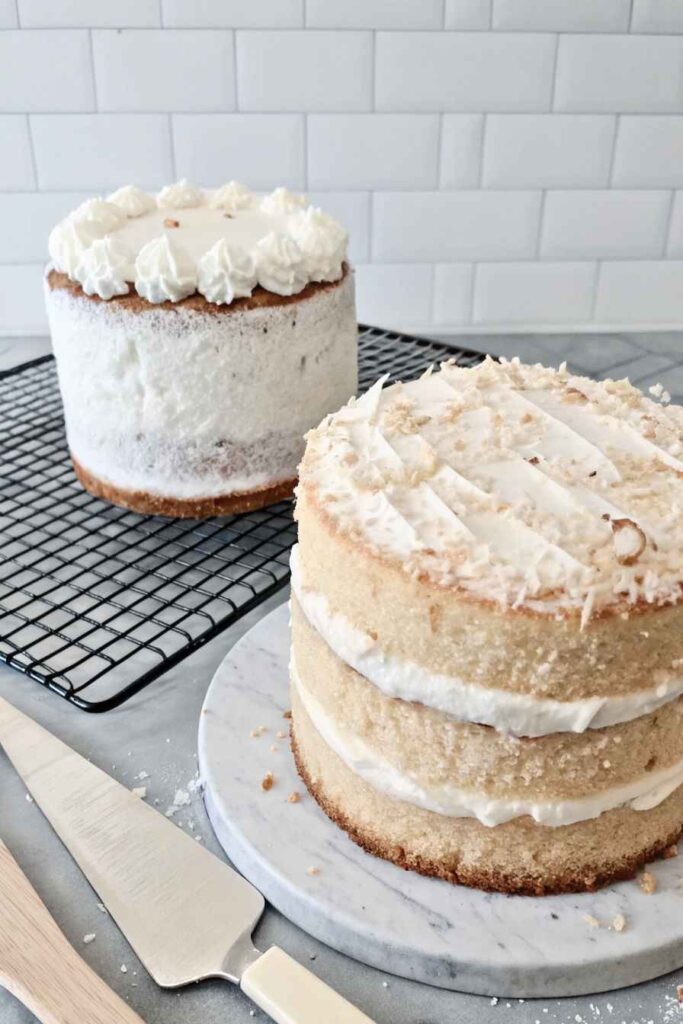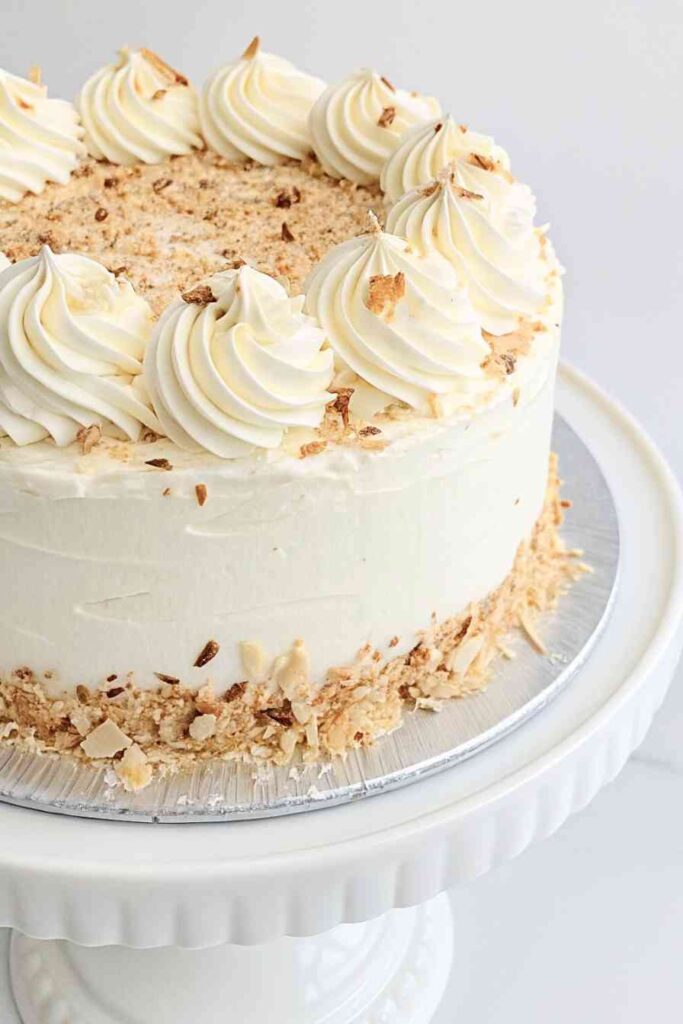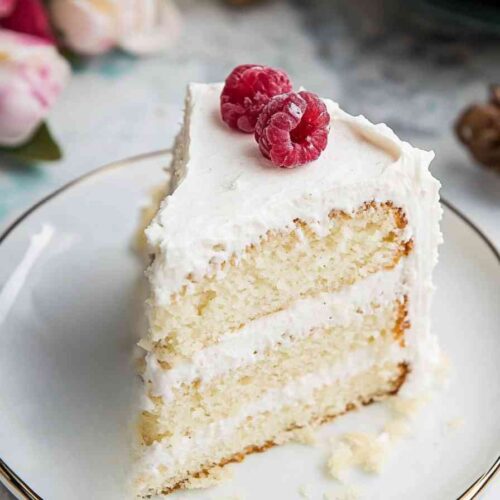Coconut Cream Cake: A Slice of Nostalgia and Comfort
There’s something incredibly nostalgic about a slice of coconut cream cake. Every bite takes me back to family gatherings and special celebrations. Light, fluffy, and packed with that irresistible tropical flavor, this cake has won over hearts for generations. Whether it’s for a birthday, a summer barbecue, or just because you’re in the mood for something sweet, coconut cream cake always hits the spot. What I love most about it isn’t just the taste—it’s the perfect blend of creamy coconut filling, moist cake layers, and that soft, pillowy frosting that makes each slice feel like a little piece of heaven.
For me, coconut cream cake has always been a go-to for those moments when I want something comforting and delicious. I love the process of making it from scratch, and the best part is watching everyone’s faces light up when they taste it. In this guide, we’ll walk through how to make the perfect coconut cream cake, from baking tips to flavor hacks, and even ideas for adapting it for different dietary needs.
Table of Contents
Introduction to Coconut Cream Cake
What Makes Coconut Cream Cake So Special?
At its core, coconut cream cake is all about richness and balance. The lightness of a sponge cake paired with the creamy, tropical flavor of coconut makes each layer a treat. What really sets it apart from other coconut cakes is the coconut cream—whether used as a filling, mixed into the batter, or whipped into the frosting, it’s what gives this cake its signature richness.
This coconut cream cake is a total showstopper. I mean, who can resist its fluffy, cloud-like look topped with golden toasted coconut flakes? It’s as beautiful as it is delicious. From birthday parties to holiday dinners, it’s the kind of cake that brings a comforting, crowd-pleasing touch to any table.
And the best part? It’s so versatile! You can tweak the frosting style, play with the fillings, or even infuse the sponge with coconut milk for an extra punch of flavor. No wonder it’s been one of the most beloved cakes in the U.S. for so long.
Key Ingredients for the Best Coconut Cream Cake
Choosing the Right Type of Coconut: Shredded, Flaked, or Creamed?
Not all coconut is created equal—and choosing the right kind can make or break your cake. Here’s a quick breakdown of the most commonly used forms and how each plays its role in the perfect coconut cream cake:
| Type of Coconut | Texture | Best Use |
|---|---|---|
| Shredded Coconut | Fine, moist | Folding into cake batter or layering between cake |
| Flaked Coconut | Larger pieces | Toasting for topping or decorating the cake |
| Creamed Coconut | Thick, rich paste | Used in fillings or mixed into frosting for depth |
Shredded sweetened coconut gives your sponge the right chewiness and coconut flavor, while unsweetened flaked coconut works best toasted on top for a light crunch. If you’re making your coconut cream from scratch or upgrading the flavor of store-bought frosting, adding creamed coconut or coconut milk is a winning move.
Importance of Full-Fat Coconut Cream in Cake Texture
Don’t skimp on the fat—full-fat coconut cream is non-negotiable when it comes to achieving that rich, dreamy consistency in your coconut cream cake. It adds moisture to your cake and gives that creamy mouthfeel to both the frosting and filling, which is what makes a coconut cream cake so indulgent. Avoid using “lite” coconut cream or watered-down coconut milk substitutes, as they can result in a drier texture and diluted flavor, taking away from the delicious richness that defines a perfect coconut cream cake.
Here’s why it matters:
- Fat binds moisture, keeping your cake soft for days.
- It creates a luxurious texture in frostings and fillings.
- High-fat content intensifies the coconut aroma and taste.
When shopping, look for brands where coconut is the first ingredient and avoid those packed with gums or fillers. Shake the can—if it sounds watery, skip it. Opt for one that has a solid creamy top when opened.
Step-by-Step Coconut Cream Cake Recipe
Preparing the Moist Coconut Cake Layers
To get that signature fluffy texture with a subtle coconut flavor, you’ll need the right technique. Here’s how to build a base that’s light, moist, and irresistible.
Ingredients for the Cake Layers:
- Cake flour (sifted)
- Baking powder
- Salt
- Unsalted butter (softened)
- Granulated sugar
- Egg whites (room temperature)
- Pure vanilla extract
- Coconut extract
- Full-fat coconut milk
- Sour cream
- Sweetened shredded coconut
Step-by-Step Instructions:
- Preheat your oven to 350°F (175°C). Grease and line three 8-inch cake pans.
- Sift together cake flour, baking powder, and salt in a large bowl.
- In a stand mixer, cream the butter and sugar on high until pale and fluffy (about 3-4 minutes).
- Add egg whites one at a time, mixing well after each. Then mix in vanilla and coconut extracts.
- In a separate bowl, whisk coconut milk and sour cream until smooth.
- Alternately add dry ingredients and the milk mixture into the creamed butter, beginning and ending with dry.
- Fold in shredded coconut with a spatula for texture.
- Divide the batter evenly into the pans and bake for 25–28 minutes, or until a toothpick comes out clean.
- Let the cakes cool for 10 minutes in the pans, then remove and cool completely on wire racks.
This base gives you light and fluffy layers that soak up all the coconut flavor without being overly dense.
Making the Silky Coconut Cream Filling and Frosting
This is where the coconut cream shines—smooth, lush, and packed with flavor.
Ingredients for the Coconut Cream Filling:
- Full-fat coconut cream
- Powdered sugar
- Coconut extract
- Cornstarch (for thickness, optional)
Steps:
- Chill the coconut cream overnight. Scoop out the solid part into a mixing bowl.
- Add sugar and extract, and beat until smooth. For a firmer filling, beat in cornstarch.
- Chill for 30 minutes before spreading between layers.
Ingredients for the Coconut Frosting:
- Unsalted butter (room temperature)
- Powdered sugar
- Coconut cream
- Vanilla extract
- Coconut extract
- Pinch of salt
Steps:
- Beat butter until creamy. Add powdered sugar 1 cup at a time, mixing slowly.
- Add coconut cream, extracts, and salt. Beat on high for 3–4 minutes until fluffy.
- Spread a generous layer on each cooled cake layer. Use the rest to frost the entire cake.

Pair this cake with one of our refreshing tropical drinks for the ultimate dessert experience.
Baking Tips to Elevate Your Coconut Cream Cake
How to Keep Your Cake Moist and Fluffy
Coconut cream cake should never be dry or dense. Getting that cloud-like texture is all about technique and ingredient balance. Here’s how to make sure your layers come out tender and moist every time:
1. Use cake flour instead of all-purpose flour.
Cake flour has less protein, which results in a finer crumb and lighter bite.
2. Don’t overmix your batter.
Once you add flour, mix until just combined. Overworking it can activate the gluten, which toughens the cake.
3. Room temperature ingredients are a must.
Eggs, butter, and coconut milk should be at room temp. It helps them blend evenly and trap more air for fluffiness.
4. Add sour cream for richness.
Sour cream brings moisture and a little tang to balance the sweetness of the coconut.
5. Brush your cake layers with coconut milk.
After baking, gently brush cooled layers with sweetened coconut milk to lock in extra moisture.
Frosting and Decoration Ideas
Coconut Cream Cheese Frosting vs Buttercream
When it comes to topping your coconut cream cake, two heavyweights go head to head: cream cheese frosting and buttercream. Each brings its own vibe, so let’s break it down.
| Feature | Coconut Cream Cheese Frosting | Coconut Buttercream Frosting |
|---|---|---|
| Texture | Silky, soft, slightly dense | Fluffy, airy, rich |
| Flavor Profile | Tangy-sweet with coconut richness | Smooth and buttery with coconut notes |
| Sweetness Level | Milder, more balanced | Sweeter, dessert-forward |
| Best For | Layered cakes, filled cakes | Piping, swirls, tall cake decorations |
Cream cheese frosting is ideal if you want a slightly tangy contrast to the sweet coconut. It also spreads like a dream, especially when chilled.
Buttercream, on the other hand, gives that classic birthday-cake feel and holds shape well for decorative piping.
Pro tip: Whip in coconut cream or extract to both for an authentic, luscious tropical flavor. If you’re feeling fancy, fold in whipped coconut milk for a lighter texture.

Creative Toppings: Toasted Coconut, White Chocolate, or Fresh Fruit
Don’t just stop at the frosting—toppings are your canvas for creativity and flavor.
Top Decoration Ideas:
- Toasted Coconut Flakes:
Sprinkle generously over the top and sides. Adds crunch and golden contrast. - White Chocolate Drizzle:
Melt and drizzle over the cake for a glossy finish. You can also create curls using a peeler. - Coconut Chips & Powdered Sugar Dusting:
A rustic, snowy effect that looks straight out of a bakery window. - Tropical Fruit Garnish:
Add thin slices of mango, pineapple, or even lime zest for a fresh twist. - Edible Flowers:
Think orchids or violets for an elegant island-inspired touch.
Storing and Serving Coconut Cream Cake
How Long Does Coconut Cream Stay Fresh?
Coconut cream plays a crucial role in your cake’s filling and frosting, so freshness matters. Unopened canned coconut cream lasts 12–18 months in a cool, dry place. Once opened, refrigerate and use within 5–7 days. Homemade coconut cream is best fresh but lasts up to 3 days in the fridge. Toss it if it smells sour, shows mold, or has unusual separation. For stable, creamy results, always use well-chilled, fresh coconut cream.
Best Ways to Store Coconut Cake (Fridge vs Counter)
Your coconut cream cake is a perishable dessert—especially when loaded with coconut cream, sour cream, or cream cheese. Here’s how to keep it safe and scrumptious:
| Storage Method | How Long It Lasts | Tips |
|---|---|---|
| Room Temperature | Up to 2 hours only | Cover lightly to prevent drying out |
| Refrigerator | 4–5 days | Store in airtight container or cake dome |
| Freezer | Up to 2 months (unfrosted preferred) | Wrap each layer in plastic + foil |
Quick Tips:
- Let the Let the coconut cream cake come to room temperature for 20–30 minutes before serving to soften the frosting and enhance flavor.come to room temperature for 20–30 minutes before serving to soften the frosting and enhance flavor.
- If refrigerating, place a slice of wax paper on the cut edge to prevent drying.
- Freeze individual slices by wrapping tightly and storing in freezer-safe containers.
Dietary Adaptations and Substitutions
How to Make Coconut Cream Cake Vegan or Gluten-Free
Whether you’re baking for dietary restrictions or simply prefer a plant-based lifestyle, you can still enjoy a delicious slice of coconut cream cake. Here’s how to do it:
Vegan Coconut Cream Cake Adaptation
What to replace:
| Traditional Ingredient | Vegan Substitute |
|---|---|
| Eggs | Flax eggs (1 tbsp flaxseed + 3 tbsp water per egg) or aquafaba |
| Butter | Vegan butter or coconut oil |
| Sour Cream | Vegan sour cream or plain coconut yogurt |
| Milk | Full-fat canned coconut milk |
| Cream Cheese (for frosting) | Vegan cream cheese (almond- or soy-based) |
Pro tip: Use chilled full-fat coconut milk to whip into frosting if vegan cream cheese is unavailable.
Bonus: Many coconut products—shredded coconut, coconut flour, coconut milk—are naturally vegan, so you’re already halfway there!

Gluten-Free Coconut Cream Cake Adaptation
How to go gluten-free without compromising structure:
- Use a gluten-free all-purpose flour blend with xanthan gum for structure.
- Avoid coconut flour as a full substitute; it absorbs too much moisture and changes the cake’s texture.
- Add an extra egg or ¼ cup of unsweetened applesauce to prevent crumbliness.
Baking Tip: Let your gluten-free batter sit for 15–20 minutes before baking to hydrate the flour and reduce grittiness.
Healthier Swaps Without Losing Flavor
Trying to cut back on sugar or fat? You don’t have to sacrifice taste. Here are some guilt-free upgrades:
| Original Ingredient | Healthier Option | Why It Works |
|---|---|---|
| White Sugar | Coconut sugar or maple syrup | Adds depth and lower glycemic index |
| Butter | Avocado oil or unsweetened applesauce | Reduces saturated fat, keeps moisture |
| Cream Cheese | Greek yogurt or light cream cheese | Lighter, protein-packed frosting |
| All-purpose flour | Whole wheat pastry flour | Adds fiber and nutrients |
Flavor Hack: Adding toasted coconut and a splash of coconut extract can distract from any textural changes when using lighter ingredients.
Common Mistakes and How to Fix Them
Why Your Cake May Turn Out Dry or Dense
If your coconut cream cake doesn’t come out fluffy and moist, don’t worry—you’re not alone. Here are the top issues and how to troubleshoot them:
1. Overmixing the Batter
The mistake: Overworking the flour develops too much gluten, resulting in a dense, chewy texture.
The fix: Mix only until ingredients are just combined—especially after adding flour.
2. Not Measuring Flour Correctly
The mistake: Scooping flour with your measuring cup can lead to packing, adding too much flour.
The fix: Spoon the flour into your measuring cup and level it off with a knife.
3. Skimping on Fat
The mistake: Using low-fat coconut milk or substituting all butter with oil.
The fix: Stick with full-fat coconut cream or whole-fat dairy for richness and moisture.
4. Overbaking the Cake
The mistake: Leaving the cake in too long dries it out.
The fix: Check with a toothpick 3 minutes before the minimum time listed. It should come out with a few moist crumbs—not dry.
5. Cake Layers Too Thin or Uneven
The mistake: Unevenly dividing batter or using the wrong pan size.
The fix: Weigh batter and use 8-inch pans with at least 2-inch sides. Trim layers if needed after baking.
How to Avoid Curdled Frosting or Runny Cream
Coconut cream frosting and filling can be a little tricky—especially if you’re working in a warm kitchen or using the wrong type of cream.
1. Using Warm Ingredients
The mistake: If your butter or coconut cream is too warm, it won’t hold structure.
The fix: Chill ingredients before whipping, and always work in a cool room.
2. Not Beating Long Enough
The mistake: Under-mixed frosting = grainy texture.
The fix: Beat until the mixture is fluffy, smooth, and light in color—about 3–5 minutes on medium-high speed.
3. Choosing the Wrong Coconut Cream
The mistake: Using coconut milk instead of coconut cream makes your frosting too runny.
The fix: Always use the thick, chilled cream from the top of the can—never the liquid below.
4. Frosting a Warm Cake
The mistake: Even slightly warm cake layers will melt your frosting.
The fix: Make sure cakes are completely cool before assembling. Chill them if needed.
Frequently Asked Questions About Coconut Cream Cake
How long does coconut cream stay fresh?
Coconut cream stays fresh for 5 to 7 days once opened, as long as it’s refrigerated in an airtight container. Unopened canned coconut cream can last up to 12–18 months when stored in a cool, dry place. Always check for sour smell, unusual separation, or mold before using.
How long can coconut cream cake sit out?
If your coconut cream cake contains dairy or cream cheese frosting, it should sit at room temperature for no more than 2 hours. After that, it should be refrigerated. Cakes with only dry ingredients or shelf-stable frostings can sit out for a day, but refrigeration is best for safety and freshness.
How do you increase coconut flavor in a cake?
To maximize coconut flavor:
- Use full-fat coconut milk or coconut cream in the batter.
- Add pure coconut extract for aroma.
- Fold in sweetened shredded or toasted coconut.
- Brush baked layers with coconut rum or coconut syrup for an extra kick.
Layering these techniques builds a rich, deep coconut profile in every bite.
Should coconut cream be thick?
Yes. Good-quality coconut cream should be thick, almost paste-like when chilled. If it’s too watery, it won’t whip properly or hold its structure in fillings and frostings. Always use full-fat coconut cream for best results and chill it overnight before using.
Does coconut cream have a strong flavor?
Coconut cream has a rich and mildly sweet coconut flavor—stronger than coconut milk, but not overpowering. It blends beautifully with vanilla, cream cheese, and butter, adding depth without overwhelming the cake.

Coconut Cream Cake Recipe Card
Ingredients
Cake Layers:
- 2½ cups cake flour (sifted)
- 1 tbsp baking powder
- ½ tsp salt
- 1 cup unsalted butter (softened)
- 1¾ cups granulated sugar
- 5 egg whites (room temperature)
- 1 tsp pure vanilla extract
- 1 tsp coconut extract
- 1 cup full-fat coconut milk
- ½ cup sour cream
- 1½ cups sweetened shredded coconut
Coconut Cream Filling:
- 1 can full-fat coconut cream (chilled overnight)
- ⅓ cup powdered sugar
- 1 tsp coconut extract
- 1 tbsp cornstarch (optional for extra thickness)
Coconut Frosting:
- 1½ cups unsalted butter (room temperature)
- 4 cups powdered sugar
- ¼ cup coconut cream (use the thick part from top of can)
- 1 tsp vanilla extract
- ½ tsp coconut extract
- Pinch of salt
Optional Garnish:
- Toasted coconut flakes
- White chocolate curls
- Lime zest or fresh berries
Instructions
Make the Cake Layers:
- Preheat oven to 350°F (175°C). Grease and line three 8-inch cake pans.
- In a bowl, sift together flour, baking powder, and salt.
- In a stand mixer, cream butter and sugar for 3–4 minutes until fluffy.
- Beat in egg whites one at a time. Add vanilla and coconut extracts.
- Mix coconut milk and sour cream in a small bowl.
- Alternate adding dry ingredients and wet mixture into the creamed butter, starting and ending with flour. Mix just until combined.
- Fold in shredded coconut.
- Divide evenly into pans. Bake for 25–28 minutes or until a toothpick comes out clean.
- Cool for 10 minutes in pans, then remove and cool completely.
Prepare the Coconut Cream Filling:
- Scoop chilled coconut cream into a bowl.
- Beat with powdered sugar and coconut extract until smooth.
- For extra firmness, beat in cornstarch. Chill for 30 minutes.
Make the Frosting:
- Beat butter until light. Slowly add powdered sugar.
- Add coconut cream, extracts, and salt. Beat for 3–4 minutes until fluffy.
Assemble the Cake:
- Level cake layers if needed.
- Spread coconut cream filling between layers.
- Frost the outside with coconut buttercream.
- Decorate with toasted coconut and optional toppings.
Notes
🧁 Notes:
- For stronger coconut flavor, add 1 tbsp coconut rum to the frosting or cake layers.
- Vegan or gluten-free? Swap eggs for flax eggs, use vegan butter and sour cream, and gluten-free flour blend with xanthan gum.
Conclusion
Whether you’re a seasoned baker or just dipping your toes into coconut desserts, this guide gives you everything you need to make a coconut cream cake that’s moist, flavorful, and unforgettable. From mastering silky coconut frosting to avoiding the most common baking mistakes, you’ve now got all the tools to whip up a showstopping cake that everyone will remember. Perfect for holidays, birthdays, or just a sweet escape to the tropics—this coconut cream cake is as versatile as it is delicious.
Looking for inspiration? Try our desserts list and find your next treat.






2 thoughts on “Coconut Cream Cake: The Ultimate Guide to a Fluffy, Flavorful Delight”